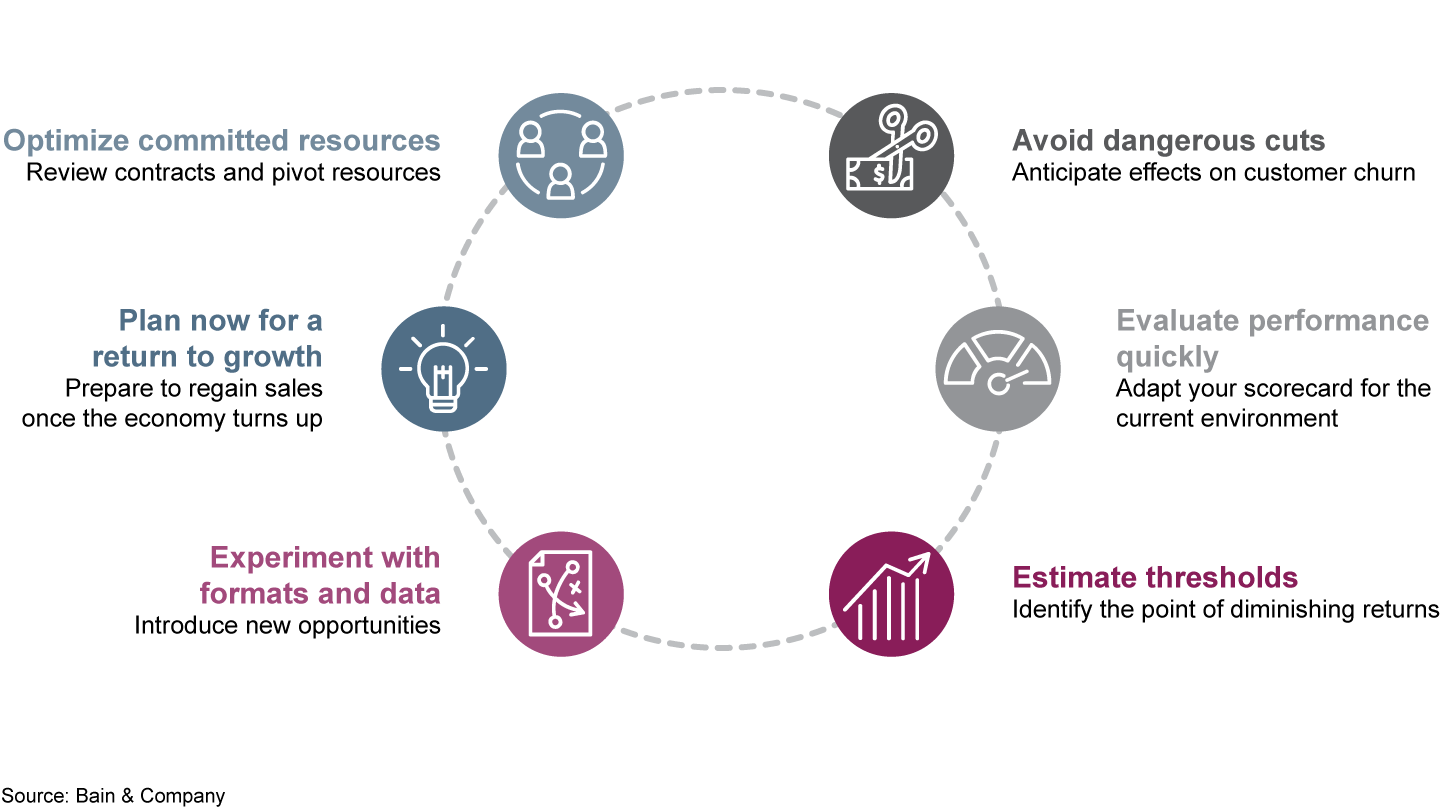Brief

Beyond the immense toll the coronavirus has taken on people’s health, employment prospects and household finances, the turbulence has rattled many corporate functions. Finance teams have begun to put the brakes on spending and protect cash flow.
They often look first to marketing budgets. The March issue of the WARC Global Marketing Index shows an accelerating decline in traditional media budgets and a drop in global staffing levels.

Macro Surveillance Platform
For more detail on the business implications of coronavirus from Bain’s Macro Trends Group, log on to the Macro Surveillance Platform. Learn more about the platform >
However, hasty or blanket cuts can severely damage sales and the brand’s stature. In the 1990–91 recession, McDonald’s decided to drop its advertising and promotion budget, but Pizza Hut and Taco Bell didn’t follow suit. As a result, those chains both saw double-digit sales growth, while McDonald’s sales declined.
More selective cuts, on the other hand, can mitigate losses, shore up cash flow and even improve performance over the long term. One retailer, for instance, has identified roughly 20% in savings on digital and direct mail marketing spending with no negative effect on revenue.
Laying out a concrete plan for the new environment could lead to a leaner, more collaborative marketing operation. Before temporarily pausing or shifting marketing activities, it’s critical to understand what aspects of marketing currently drive spending and whether those drivers still apply. Other drivers may have quickly emerged as more important.
Only with that understanding in place can marketing executives draw up a reliable plan and budget. Our observations of what leading marketers have done so far during the pandemic, combined with smart moves made in previous economic crises, suggest a short set of guiding principles (see Figure 1).


Optimize committed resources
Review all working and nonworking marketing spending in detail, mapping it across items in the marketing plan and brands. Some spending consists of locked-in commitments with agency partners, tools and media bookings. It’s well worth reviewing the contract terms with an eye to repurposing, renegotiating or shifting to a higher-return activity. Don’t shy away from cutting sacred cows.
Avoid cuts that spur churn or raise acquisition costs
Reclaiming certain spending items could cause damage in the long run. For instance, it could take up to nine months to recover from a halt in search engine optimization, while cuts to paid search could raise the cost per customer acquisition. Handbrakes on all brand spending will likely increase the cost per acquisition or rates of customer churn.
Moreover, a wholesale cut to awareness and consideration campaigns will affect a firm’s performance marketing cost and results. While this may be unavoidable, make sure to evaluate the two metrics together. It may be more efficient to protect spending that spurs consumer consideration of your products.
Evaluate performance quickly
A rapid analysis of marketing performance should be based on key performance indicators and benchmarks adapted for the current climate, consumer needs and business objectives. Prioritize spending areas to identify candidates to cut with no regrets; test other areas further to determine if they should survive in the new plan.
Estimate thresholds for diminishing returns
In most high-performing media channels, there is a threshold beyond which marketers see diminishing returns in the form of higher costs or lower response. It’s important to estimate at what point you should stop investing and where you still have headroom. And if you cut all brand spending, the thresholds for performance activity may go down. Once you establish an estimate, quickly reassign budgets to high-performing channels that have not yet reached the threshold.
Given the fluid nature of the pandemic and economic fallout, it makes sense to move to shorter planning terms and reviews, whether or not the finance cycle demands it. Weekly performance reviews and test results should inform the new plan and quarterly budget.
Experiment with formats and data
While the main tasks right now are simplification and cost reduction, marketers also have an opportunity to experiment. Explore opportunities such as new creative formats, rapid testing of new media, novel uses for first-party data or possible partnerships. One restaurant chain cut the length of its online video ads from 15 seconds to 6 seconds, reducing cost while realizing a higher rate of brand recall.
Plan now for a return to growth
Based on what they learn from this process of realigning costs, marketers can prepare a transition plan for regaining revenue once the economy turns up again. Light-commitment media plans and creative plays can be ready to deploy when a full budget returns.
Of course, the entire process hinges on having the right tools and capabilities for a modern marketing operation: cross-functional teams, a test-and-learn mentality, high-caliber reporting and analysis, and a bias-free, data-driven mindset. These capabilities will benefit a marketing operation not only in a crisis but at any stage of the economic cycle.

Coronavirus
The global Covid-19 pandemic has extracted a terrible human toll and spurred sweeping changes in the world economy. Across industries, executives have begun reassessing their strategies and repositioning their companies to thrive now and in the world beyond coronavirus.
Blake Cuthbert is a vice president and Sonia Sudhakar is a principal at FRWD, Bain & Company’s digital marketing practice. They are based in London. Sharona Sankar-King is an expert vice president with Bain’s Customer Strategy & Marketing practice. She is based in New York.